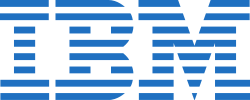IBM System/32
The IBM System/32 (IBM 5320) introduced in January 1975[1] was a low-end business computer with builtin display screen, disk drives, printer, and database report software. It was used primarily by small to midsize businesses for accounting applications. RPG II was the primary programming language for the machine.[2]
 | |
| Manufacturer | International Business Machines Corporation (IBM) |
|---|---|
| Product family | System/32 |
| Release date | January 7, 1975 |
| Discontinued | October 17, 1984 |
| Predecessor | IBM System/3 |
| Successor | IBM System/34 |
| Website | Official website IBM Archives |
Overview
The 16-bit single-user System/32, also known as the IBM 5320, was introduced in 1975,[3] and it was the successor to the IBM System/3 model 6 in the IBM midrange computer line. IBM described it as "the first system to incorporate hardware and comprehensive application software."[3] Within 40 months, "the System/32 had surpassed the IBM System/3 as the most installed IBM computer."[3]
The computer looked like a large office desk with a very small six-line by forty-character display and a keyboard similar to an IBM keypunch. The machine had a built-in line printer, that directly faced the operator when seated, and could print reports, memos, billing statements, address labels, etc.
The system, which had been introduced January 7, 1975 was withdrawn from marketing on October 17, 1984. Migration to the IBM System/34 was generally simple because source code was compatible and programs just needed recompilation.
Having the appearance of a computerized desk, the System/32 was nicknamed the "Bionic Desk" after The Six Million Dollar Man (bionic man), a popular U.S. TV program when the computer was introduced in 1975.
Memory/storage
It had 16 kB or 32 kB of main memory.
A single hard drive was available in one of three sizes:[4]
- 5 MB
- 9 MB
- 13 MB
The system included an eight-inch floppy drive that could also read floppies from the IBM 3740 family.
Only one side of the 77-track floppy diskette was used. Each track held 26 128-byte sectors. An extended format was offered by IBM, and it permitted 512 bytes per sector. Even so, that came to an 8-inch floppy holding less than one third of a megabyte.[5]
System/32 operator
When keying input data, the operator would be viewing the character display, which was also common to the then current IBM 3740 family of data entry to floppy disk media.
A computer specialist was not required for the operation of System/32.
SEU, DFU, OCL, and #LIBRARY
Some terms associated with the System/32 include:
- SEU (Source Entry Utility, the programming editor),
- DFU (Data File Utility, a query and report generator),[6]
- OCL (Operations Control Language, the command-line language), and
- #LIBRARY (the directory or disk partition in which executable code was stored).
References
- IBM Archives: IBM System/32
- "SR30-0017-1 System32 RPG II Programming".
- "IBM System/32". IBM Corporation.
- with 5 more choices added a year later Computerworld. January 19, 1976 https://books.google.com/books?id=Uy7sCK_QJ9QC. Missing or empty
|title=(help) - "Floppy drive".
- "IBM System/32 Data File Utility (DFU)".